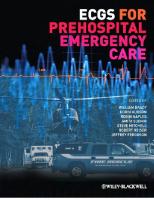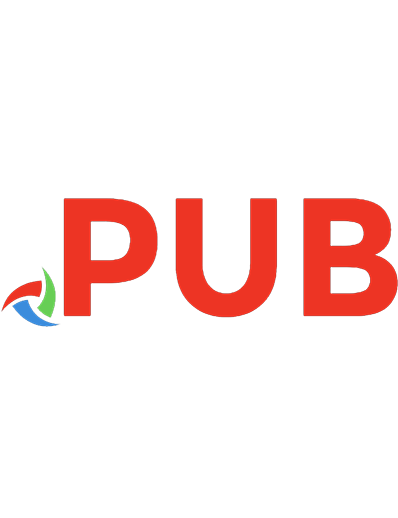Prehospital emergency care [10. ed.] 9780133369137, 0133369137
939 142 135MB
English Pages [1441] Year 2014
Table of contents :
Cover
Title Page
Copyright Page
Acknowledgments
Contents
Key Features
EMT Skills
Preface
What’s New in the 10th Edition?
About the Authors
PART 1 Preparatory/Public Health
1 Emergency Medical Care Systems, Research, and Public Health
Introduction
The Emergency Medical Services System
The EMT
Research and EMS Care
Public Health
2 Workforce Safety and Wellness of the EMT
Introduction
Emotional Aspects of Emergency Care
Scene Safety
Wellness Principles
3 Medical, Legal, and Ethical Issues
Introduction
The Scope of Practice
Issues of Patient Consent and Refusal
Other Legal Aspects of Emergency Care
4 Documentation
Introduction
Functions of the Prehospital Care Report
Collection of Data in Prehospital Care Reports
Legal Concerns
Special Situations
Alternative Documentation Methods
Medical Abbreviations
5 Communication
Introduction
EMS Communications System
Communicating Within the System
Team Communication and Dynamics
Therapeutic Communication
6 Lifting and Moving Patients
Introduction
Body Mechanics for Safe Lifting
General Guidelines for Lifting and Moving
Lifting and Moving Patients
Packaging for Transportation
General Guidelines for Carrying a Patient Using a Backboard, Portable Stretcher, or Flexible Stretcher
PART 2 Anatomy and Physiology/Medical Terminology
7 Anatomy, Physiology, and Medical Terminology
Introduction
Anatomical Terms
Body Systems
Medical Terminology
PART 3 Pathophysiology
8 Pathophysiology
Introduction
Cellular Metabolism
Components Necessary for Adequate Perfusion
PART 4 Life Span Development
9 Life Span Development
Introduction
Life Span Development
PART 5 Airway Management, Respiration, and Artificial Ventilation
10 Airway Management, Artificial Ventilation, and Oxygenation
Introduction
Respiration
Respiratory System Review
Airway Assessment
Assessment of Breathing
Assessing for Adequate Breathing
Making the Decision to Assist Ventilation or Not
Techniques of Artificial Ventilation
Special Considerations in Airway Management and Ventilation
Oxygen Therapy
PART 6 Assessment
11 Baseline Vital Signs, Monitoring Devices, and History Taking
Introduction
Gathering Patient Information
Baseline Vital Signs
Monitoring Equipment
Preparing to Take the History
Taking the History
12 Scene Size-up
Introduction
Take the Necessary Standard Precautions and Other Personal Protection Precautions
Determine Scene Safety
Determine the Nature of the Problem
Determine the Number of Patients
13 Patient Assessment
Introduction
Part 1: Scene Size-up
Part 2: Primary Assessment
Form a General Impression of the Patient
Assess Level of Consciousness (Mental Status)
Assess the Airway
Assess Breathing
Assess Oxygenation
Assess Circulation
Establish Patient Priorities
Part 3: Secondary Assessment
Overview of Secondary Assessment: Anatomical and Body Systems Approaches, Baseline Vital Signs, and History
Secondary Assessment: Trauma Patient
Reevaluate the Mechanism of Injury
Rapid Secondary Assessment: Trauma Patient with Significant Mechanism of Injury, Altered Mental Status, Multiple Injuries, or Critical Finding (Unstable)
Modified Secondary Assessment: Trauma Patient with NO Significant Mechanism of Injury, Altered Mental Status, Multiple Injuries, or Critical Finding (Stable)
Secondary Assessment: Medical Patient
Medical Patient Who Is Not Alert or Is Disoriented, Is Responding Only to Verbal or Painful Stimuli, or Is Unresponsive
Responsive Medical Patient Who Is Alert and Oriented
Part 4: Reassessment
Purposes of the Reassessment
Repeat the Primary Assessment
Complete the Reassessment
PART 7 Pharmacology
14 Pharmacology Medication and Administration
Introduction
Administering Medications
Medications Commonly Administered by the EMT
Medication Names
Routes of Administration
Medication Forms
Essential Medication Information
Key Steps in Administering Medications
Reassessment Following Administration
Sources of Medication Information
PART 8 Shock and Resuscitation
15 Shock and Resuscitation
Introduction
Shock
Resuscitation in Cardiac Arrest
Automated External Defibrillation and Cardiopulmonary Resuscitation
Recognizing and Treating Cardiac Arrest
Special Considerations for the AED
PART 9 Medicine
16 Respiratory Emergencies
Introduction
Respiratory Anatomy, Physiology, and Pathophysiology
Respiratory Distress
Pathophysiology of Conditions That Cause Respiratory Distress
Metered-Dose Inhalers and Small-Volume Nebulizers
Age-Related Variations: Pediatrics and Geriatrics
Assessment and Care: General Guidelines
17 Cardiovascular Emergencies
Introduction
Review of the Circulatory System Anatomy and Physiology
Cardiac Compromise and Acute Coronary Syndrome (ACS)
Nitroglycerin
Age-Related Variations: Pediatrics and Geriatrics
Assessment and Care: General Guidelines
18 Altered Mental Status, Stroke, and Headache
Introduction
Altered Mental Status
Stroke
Headache
19 Seizures and Syncope
Introduction
Seizure
Syncope
20 Acute Diabetic Emergencies
Introduction
Understanding Diabetes Mellitus
Acute Diabetic Emergencies
Assessment-Based Approach: Altered Mental Status in a Diabetic Emergency
21 Anaphylactic Reactions
Introduction
Anaphylactic Reaction
22 Toxicologic Emergencies
Introduction
Poisons and Poisonings
Ingested Poisons
Inhaled Poisons
Injected Poisons
Absorbed Poisons
Specific Types of Poisoning
Poison Control Centers
Drug and Alcohol Emergencies
Specific Substance Abuse Considerations
23 Abdominal, Hematologic, Gynecologic, Genitourinary, and Renal Emergencies
Introduction
Acute Abdomen
Hematologic Emergencies
Gynecologic Emergencies
Genitourinary/Renal Emergencies
24 Environmental Emergencies
Introduction
Heat and Cold Emergencies
Exposure to Cold
Exposure to Heat
Bites and Stings
Lightning Strike Injuries
High-Altitude Sickness
25 Submersion Incidents: Drowning and Diving Emergencies
Introduction
Water-Related Emergencies
Scuba or Deepwater Diving Emergencies
26 Behavioral Emergencies
Introduction
Behavioral Problems
Dealing with Behavioral Emergencies
Legal Considerations
PART 10 Trauma
27 Trauma Overview: The Trauma Patient and the Trauma System
Introduction
The Kinetics of Trauma
Mechanisms of Injury
The Multisystem Trauma Patient
The Golden Period and Platinum Ten Minutes
The Trauma System
Golden Principles of Prehospital Trauma Care
28 Bleeding and Soft Tissue Trauma
Introduction
External Bleeding
Internal Bleeding
Factors That May Increase Bleeding
Hemorrhagic Shock
Soft Tissue Trauma
Closed Soft Tissue Injuries
Open Soft Tissue Injuries
Dressings and Bandages
29 Burns
Introduction
The Skin: Structure and Function Review
Airway, Breathing, Oxygenation, and Circulation
Effects of Burns on Body Systems
Assessment and Care of Burns
30 Musculoskeletal Trauma and Nontraumatic Fractures
Introduction
Musculoskeletal System Review
Injuries to Bones and Joints
Basics of Splinting
Nontraumatic Fractures
31 Head Trauma
Introduction
Anatomy of the Skull and Brain
Head Injury
32 Spinal Column and Spinal Cord Trauma
Introduction
Anatomy and Physiology of Spine Injury
Emergency Care for Suspected Spine Injury
Guidelines for Immobilization
Special Considerations
33 Eye, Face, and Neck Trauma
Introduction
Anatomy of the Eye, Face, and Neck
Eye, Face, and Neck Injuries
Specific Injuries Involving the Eye, Face, and Neck
34 Chest Trauma
Introduction
The Chest
35 Abdominal and Genitourinary Trauma
Introduction
The Abdomen
Genital Trauma
36 Multisystem Trauma and Trauma in Special Patient Populations
Introduction
Multisystem Trauma
Trauma in Special Patient Populations
Assessment-Based Approach: Multisystem Trauma and Trauma in Special Patient Populations
PART 11 Special Patient Populations
37 Obstetrics and Care of the Newborn
Introduction
Anatomy and Physiology of the Obstetric Patient
Antepartum (Predelivery) Emergencies
Labor and Normal Delivery
Abnormal Delivery
Care of the Newborn
38 Pediatrics
Introduction
Dealing with Caregivers
Dealing with the Child
Assessment-Based Approach to Pediatric Emergencies
Airway and Respiratory Problems in Pediatric Patients
Specific Pediatric Respiratory and Cardiopulmonary Conditions
Other Pediatric Medical Conditions and Emergencies
Pediatric Trauma
Child Abuse and Neglect
Special Care Considerations
39 Geriatrics
Introduction
Effects of Aging on Body Systems
Special Geriatric Assessment Findings
Assessment-Based Approach: Geriatric Patients
40 Patients with Special Challenges
Introduction
Recognizing the Patient with Special Challenges
Sensory Impairments
Cognitive and Emotional Impairments
Paralysis
Obesity
Homelessness and Poverty
Abuse
Technology Dependence
Airway and Respiratory Devices
Vascular Access Devices
Ventricular Assist Device (VAD)
Renal Failure and Dialysis
Gastrointestinal and Genitourinary Devices
Intraventricular Shunts
Terminally III Patients
41 The Combat Veteran
Introduction
The Psychophysiology of Stress Response
Combat Veterans
The Nature of PTSD
Assessing and Providing Emergency Care to Combat Veterans: Recommendations for EMTs
PART 12 EMS Operations
42 Ambulance Operations and Air Medical Response
Introduction
Driving the Ambulance
Warning Devices
Roadway Incident Scene Safety
Phases of an Ambulance Call
Air Medical Transport
Security and Safety
43 Gaining Access and Patient Extrication
Introduction
Planning Ahead
Sizing up the Scene
Gaining Access
Extrication
Specialized Stabilization, Extrication, and Disentanglement Techniques
44 Hazardous Materials
Introduction
Identifying Hazardous Materials
Guidelines for Hazardous Materials Rescues
45 Multiple-Casualty Incidents and Incident Management
Introduction
Multiple-Casualty Incidents
National Incident Management System
Triage
Disaster Management
46 EMS Response to Terrorism Involving Weapons of Mass Destruction
Introduction
Weapons of Mass Destruction
Prehospital Response to Terrorism Involving WMD
Conventional Weapons and Incendiary Devices
Chemical Agents
Biological Agents
Nuclear Weapons and Radiation
Appendix 1 ALS-Assist Skills
Appendix 2 Advanced Airway Management
Appendix 3 Agricultural and Industrial Emergencies
Answer Key
Glossary
A
B
C
D
E
F
G
H
I
J
K
L
M
N
O
P
Q
R
S
T
U
V
W
X
Z
Index
A
B
C
D
E
F
G
H
I
J
K
L
M
N
O
P
Q
R
S
T
U
V
W
X
Y
Z
![Prehospital emergency care [10. ed.]
9780133369137, 0133369137](https://dokumen.pub/img/200x200/prehospital-emergency-care-10-ed-9780133369137-0133369137.jpg)
![Prehospital Emergency Care Test Bank [11 ed.]
9780134704487](https://dokumen.pub/img/200x200/prehospital-emergency-care-test-bank-11nbsped-9780134704487.jpg)

![Prehospital Emergency Care, 12th Edition [12 ed.]
9780137938407, 0137938403, 9780137938476, 9780137938483, 9780137942008](https://dokumen.pub/img/200x200/prehospital-emergency-care-12th-edition-12nbsped-9780137938407-0137938403-9780137938476-9780137938483-9780137942008.jpg)
![ABC of Prehospital Emergency Medicine [2 ed.]
1119698324, 9781119698326](https://dokumen.pub/img/200x200/abc-of-prehospital-emergency-medicine-2nbsped-1119698324-9781119698326.jpg)
![Emergency Medicine, Trauma and Disaster Management: From Prehospital to Hospital Care and Beyond [1st ed.]
3030341151, 9783030341152, 9783030341169](https://dokumen.pub/img/200x200/emergency-medicine-trauma-and-disaster-management-from-prehospital-to-hospital-care-and-beyond-1stnbsped-3030341151-9783030341152-9783030341169.jpg)


![Emergency Department Critical Care [1st ed.]
9783030287924, 9783030287948](https://dokumen.pub/img/200x200/emergency-department-critical-care-1st-ed-9783030287924-9783030287948.jpg)

![Non-Orthopedic Emergency Care in Athletics [1st ed.]
9781630916183](https://dokumen.pub/img/200x200/non-orthopedic-emergency-care-in-athletics-1stnbsped-9781630916183.jpg)